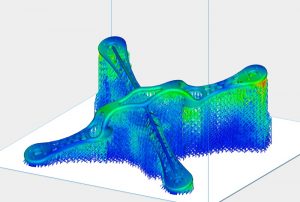Tomorrow begins formnext, one of the biggest 3D printing-related trade shows in the world. Taking place in Frankfurt, Germany, the show runs from November 13th to 16th, but the new products and other announcements have already been rolling out in the days and weeks leading up to it. Every year at formnext, Materialise introduces the latest version of its Magics data and build preparation software, and this year is no exception as Magics 23 arrives full of improvements and new features to help users become more productive and efficient.
Users of Magics 23 will enjoy more control and better integrated features. They will now be able to process large data sets faster, spend less time on data preparation, and reduce their powder consumption. They can easily create self-supporting honeycomb structures, as well as preview and analyze the structures and get full control over their orientation on the build platform. Fillets can be generated on a single edge, improving part quality.
The new Magics 23 introduces an advanced labeling feature called Data Matrix Label, which converts alphanumeric data from standard 3D printed labels into a data matrix code that can be applied to individual parts, creating smart tags that can be read by conventional data matrix scanners.
Several Magics modules have been upgraded as part of the new release.
“With the introduction of Magics 23, we offer integrated automation features for metal 3D printing, including simulation and automatic support generation,” said Stefaan Motte, Vice President and General Manager of the Materialise software division. “This allows users to drive down cost by optimizing their machine operations and reducing the number of build fails, all within their trusted Magics environment.”
 The Magics Simulation module is designed to make simulation easier and more accessible for more people, optimizing the production process without the need for expert knowledge. Users can apply simulation results directly to the support generation and orientation tools within the Magics environment. The module supports fast reruns on a standard workstation without the need for high-end processing power, and can be used in combination with other computer-aided engineering solutions for highly certified metal production. The module includes an integrated calibration feature which guides users to the correct simulation settings for their metal 3D printers.
The Magics Simulation module is designed to make simulation easier and more accessible for more people, optimizing the production process without the need for expert knowledge. Users can apply simulation results directly to the support generation and orientation tools within the Magics environment. The module supports fast reruns on a standard workstation without the need for high-end processing power, and can be used in combination with other computer-aided engineering solutions for highly certified metal production. The module includes an integrated calibration feature which guides users to the correct simulation settings for their metal 3D printers.
Magics 23 also introduces automatic support generation for metal 3D printing. Manually designing supports for metal 3D printing has always been a unique challenge that requires expert knowledge and can easily lead to part failure. A new support generation module reduces the risk by allowing users to automatically generate e-Stage supports based on designed profiles. They can more easily edit, move or delete points and receive immediate feedback on support volumes. Data preparation time can be reduced by up to 90 percent, support removal time reduced by 50 percent and powder reclamation can be achieved at nearly 100 percent compared to manual support generation. The module also reduces the likelihood of human error.
At formnext, Materialise will also be introducing three new materials: polypropylene (PP), one of the most commonly used production plastics; Taurus, an SLA material designed for automotive prototyping applications; and Inconel, a metal alloy commonly used in the aerospace and automotive industries for prototyping and end-use parts.
“The automotive, aerospace and consumer goods industries have all been early adopters of 3D printing for prototyping applications,” said Jurgen Laudus, Vice President Materialise Manufacturing. “As the usage of 3D printing widens in scope and scale, we’re making strategic investments in expanding our service portfolio with materials that address the industries’ needs: whether it’s production-grade characteristics as in the case of PP and Inconel, or specific mechanical properties as in the case of Taurus.”
Discuss this and other 3D printing topics at 3DPrintBoard.com or share your thoughts below.
[Images: Materialise]
Subscribe to Our Email Newsletter
Stay up-to-date on all the latest news from the 3D printing industry and receive information and offers from third party vendors.
You May Also Like
Further Understanding of 3D Printing Design at ADDITIV Design World
ADDITIV is back once again! This time, the virtual platform for additive manufacturing will be holding the first-ever edition of ADDITIV Design World on May 23rd from 9:00 AM –...
3D Printer Maker EVO-tech Reborn as NEVO3D — Once More With Feeling
EVO-tech was a 3D printing service and original equipment manufacturer established in 2013 and based in Schörfling am Attersee, Austria. The company produced high-quality material extrusion systems featuring linear bearings,...
3D Systems Brings 3D Printed PEEK Cranial Implant to the U.S. with FDA Clearance
For more than 10 years, 3D Systems (NYSE:DDD) has worked hand-in-hand with surgeons to plan over 150,000 patient-specific cases, and develop more than two million instruments and implants from its...
CDFAM Returns to Berlin for Second Annual Symposium
The second CDFAM Computational Design Symposium is scheduled for May 7-8, 2024, in Berlin, and will convene leading experts in computational design across all scales. Building upon the first event...

































